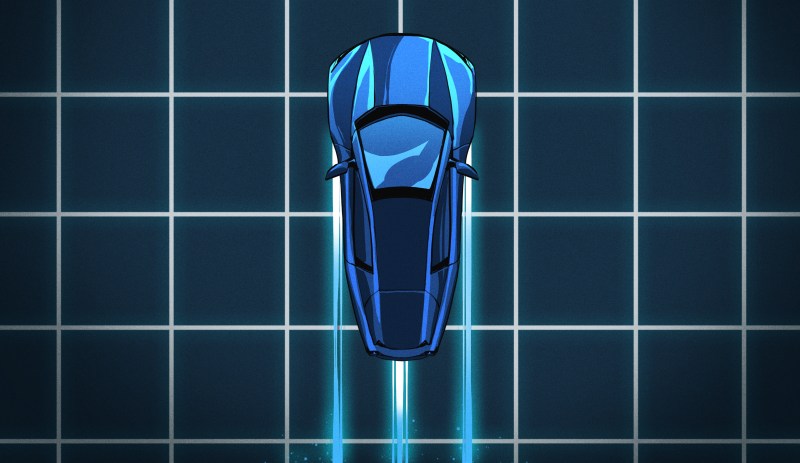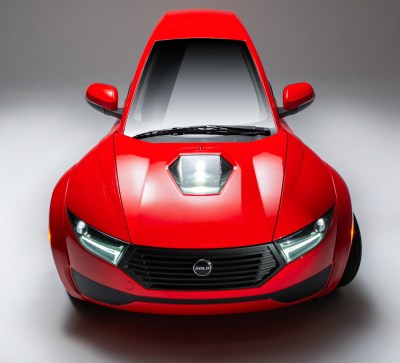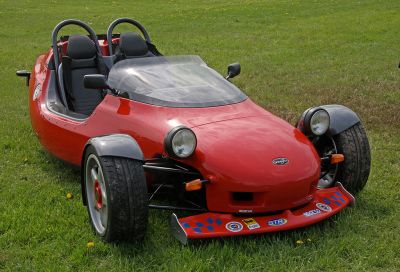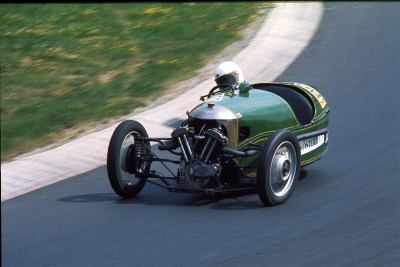
Losing A Wheel On Your Commute; 3-Wheelers Vie For The Open Road
by Jenny ListWe live at an interesting point in time for the technologically minded motor vehicle enthusiast, and we stand on the brink of a major directional shift in how we imagine a car. Within ten years it’s likely that the electric motor will have moved from an extravagance or a fringe choice to a mainstream one, and a piston engine will be the preserve of an ever smaller niche market.

Along the way is it possible that the very form factor of an automobile will change, or will cars in decades hence have the same basic shape as those we’re used to? The Canadian company Electrameccanica certainly think so, because they’ve launched a refreshingly different take on commuter transport for one. Their Solo is a three-wheeler car, with two wheels at the front and one trailing wheel at the back configuration. It’s a bold design, but if it’s such an obvious one then why don’t we drive three-wheelers already?
It’s time to examine a few of the properties of a three-wheeler, and along the way visit some of the past attempts at this configuration.
There Are More Three-Wheelers Than You Realise
It’s hardly as though three-wheelers are a new phenomenon, both the world’s first motorised vehicle created by Nicolas-Joseph Cugnot in late-18th century France and Karl Benz’s 1885 first ancestor of all modern cars had leading wheel designs. Writing this in the United Kingdom the first that come to mind are the Morgan trailing wheel sports car, the Reliant and Bond series of leading wheel small cars and vans, and maybe the Grinnall Scorpion sports car as a spiritual successor to the Morgan before Morgan decided to get back in the game themselves.

The astonishing variety of three-wheeled machines across all conceivable vehicle types already produced will probably come as a surprise to many readers. With so many tries at the formula one might expect that more of them of them would have gained long-term traction, so just what is it about three-wheelers that lacks appeal?
It’s fair to say that humans value conformity, so it’s possible that one of the steepest barriers for a new three-wheeler is the thought of what others might think should you rock up at work in one. I would drive a Reliant Robin because it’s a quirky little motor and has the last vestige of the famous Austin 7 in its automotive heritage, and I’d love to own a Piaggio Ape because it’s the epitome of Italian small farm transport and a handy little pickup truck to boot, but I’m a farm-dwelling hackerspace denizen and not a besuited drone on the corporate ladder.
As it stands, I run a retro Volkswagen and a decrepit Triumph not through necessity but because I like them; a modern would make sense in every way possible but if I had a Ford Mondeo on the drive then something inside would have died. Perhaps many readers will join me in this sentiment, but for most people the fear of ridicule or non-conformity is a powerful motivation and a Toyota Corolla is a much safer bet than a small-production car that’s a little bit weird.
We are however not here to pass social commentary, instead our purview lies in the technology of what we write about. If three-wheelers make practical small car transport, are there any technical reasons why they are inferior?
Is A Three-Wheeler Really Worse On Corners?
Despite the BBC’s Top Gear playing tricks with strategically-placed ballast to make fun of the Reliant three-wheelers as comically unstable, the truth was that they had no worse handling in the corners in normal driving conditions than many of their contemporaries in the 1950s through the ’70s. In an age of near-flawless-handling front wheel drive cars, it’s easy to forget that there was a time when many four-wheeled vehicles required an element of care to drive while staying on the road. My Triumph Herald certainly raises some doubts.
To gauge what happens when you push a car to the limit I had a chat with some of my friends in the kit car community. I also have my own knowledge from a youth misspent on motorcycles.
If you push a four wheeled car into a corner, the force increases on the outside front wheel and decreases on the rear inside one as the car is both pitched forward by deceleration and put into a roll by the centripetal force of cornering. The Mini in the picture below has its rear nearside wheel off the ground, and though the body roll has reduced the force on its front nearside wheel it still retains three wheels in contact with the road. Assuming that the contact patch of the offside wheel with the road does not lose grip from the sideways force, it retains enough contact with the road for its driver to remain in control.


Looking at a leading-wheel three-wheeler such as the Reliant tackling the same corner as the Mini then, the same forces apply upon cornering. The car will experience body roll, the front suspension will be compressed, and in extreme cornering the rear nearside wheel will lift off the ground as the Mini’s has. Where it differs from the Mini though is that its single centrally-placed front wheel then becomes a pivot point. With only two points of contact between the road and the car it becomes both far more susceptible to rolling, and the friction of the tyre contact patches countering the sideways force becomes correspondingly less than the Mini with its three wheels left on the road. In normal on-road driving the car is unlikely to reach this point, so the Top Gear piece linked above resorted to subterfuge to achieve the effect.

A trailing-wheel three-wheeler might then be expected to be the ideal configuration, its two widely-spaced front wheels providing the stability and two contact patches on corners that the Mini has, while its single rear wheel removes the tendency in four-wheel car for a rear wheel to come off the ground in cornering. All is not so perfect though, because in heavy cornering a trailing-wheel car can experience something in common with a motorcycle.
The highside is a term familiar to motorcyclists, an accident while cornering in which the rider is thrown upwards into the air over the bike. Motorcycles counter centripetal force while cornering by leaning into the corner, the highside begins when the rear tyre contact patch with the road loses grip and the rear of the bike begins to slide sideways. Inevitably after a period of this sliding sideways it momentarily retains grip, and the sideways momentum over this new pivot point causes the bike to sharply sit upright and launch the rider into the air. Exactly the same phenomenon can occur with a trailing-wheel three-wheeler under extreme cornering, causing the car to flip up and the inside front wheel to leave the ground. Instead of the driver being flung into the air the car can roll over spectacularly, as one of the kit car folks I asked related seeing a Grinnall do once while on a trackday.
Commuting, Not Racing
Neither of these doom-laden outcomes are the result of a typical cornering manoeuvre in a three-wheel car at road speeds, and cars such as the Reliants, Grinnalls, Morgans and others cover many thousands of miles each year just as their four-wheeled equivalents do. Your community general public will spend more time in bumper-to-bump than they will ripping around the corners.
The Solo looks to be an interesting car that deserves a chance to break the automotive mould, but to avoid going the way of the Corbin Sparrow before it, there has to be something exceptional in that diminutive chassis. At least unlike the Sparrow it’s got the looks for the job.